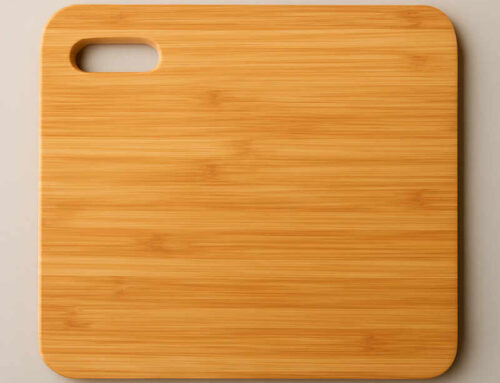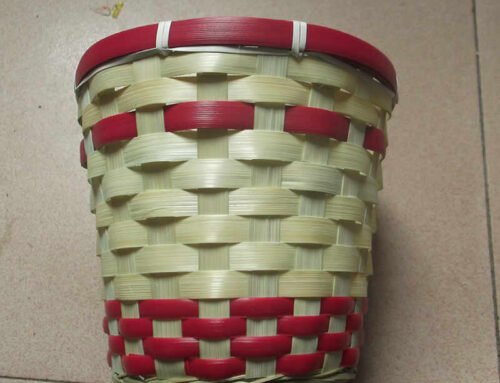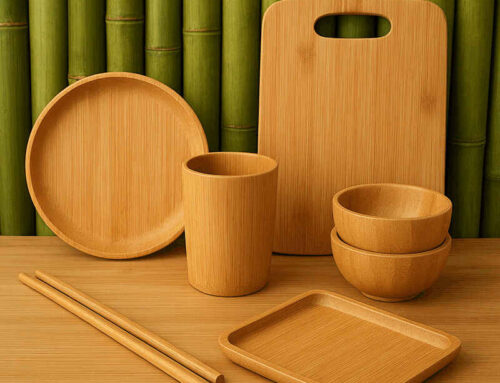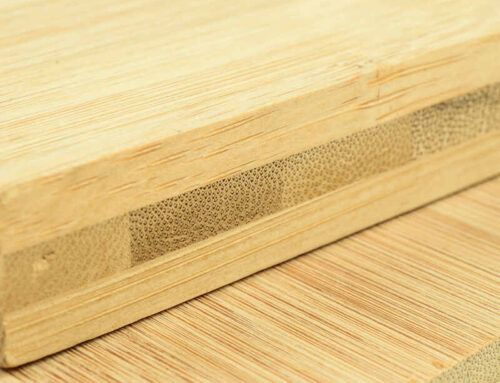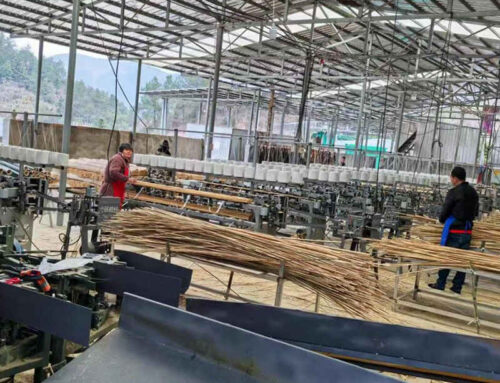Bamboo, with its remarkable strength, rapid growth, and elegant, linear beauty, has been a cornerstone of craftsmanship for millennia. From rustic furniture and woven bamboo baskets to modern decorative art and flooring, bamboo offers a sustainable and versatile material. However, its true potential and longevity are often unlocked only through a proper finish. Unlike dense hardwoods, bamboo is a grass, with a unique silica-coated surface and a fibrous structure that requires specific considerations when finishing.
Choosing the right finish for your bamboo product isn’t just about aesthetics; it’s about preservation, durability, and bringing out the natural character of the material. Whether you’re a seasoned artisan or a DIY enthusiast, this guide will walk you through everything you need to know about painting and finishing bamboo.
Part 1: Understanding Bamboo Before You Start
Before you even open a can of paint, it’s crucial to understand your canvas. Bamboo’s surface is naturally slick and non-porous because of a layer of silica. This is the plant’s natural defense against moisture and pests, but it also means that many finishes will struggle to adhere properly. If you simply use paint or varnish directly to raw bamboo, it will likely peel, chip, or wear off quickly.
What is more, bamboo is highly susceptible to moisture. If not properly sealed, it can absorb atmospheric humidity, leading to expansion, mold growth, and eventual decay. A high-quality finish acts as a protective barrier.
Part 2: Choosing the Right Finish for Your Project
The “best” finish depends entirely on the intended use of the bamboo product. Is it an outdoor chair exposed to the elements? An indoor vase? A cutting board? A child’s toy? Let’s break down the options.
Category 1: Clear Finishes (To Enhance the Natural Look)
These finishes are designed to protect the bamboo while allowing its natural color and grain to display. They are ideal for beautiful, high-quality bamboo with attractive nodes and patterns.
- Tung Oil:
- What it is: A natural, penetrating oil derived from the nut of the tung tree. It polymerizes (hardens) upon exposure to air, creating a durable, water-resistant finish.
- Best for: Indoor furniture, kitchenware (like bamboo bowls, not bamboo cutting boards), and decorative items where a natural, hand-rubbed feel is desired.
- Pros: Food-safe when fully cured, enhances the wood’s depth, repels water, easy to spot-repair.
- Cons: Long curing time (can take weeks to fully cure), requires multiple thin coats, can have a strong odor.
- Linseed Oil (Raw vs. Boiled):
- What it is: Another natural oil, made from flax seeds. Boiled Linseed Oil (BLO) has additives that speed up drying time.
- Best for: Less demanding indoor items, giving bamboo a warm, amber tone.
- Pros: Inexpensive, easy to apply, deeply penetrates.
- Cons: Not as water-resistant as tung oil. BLO contains chemical driers, making it unsuitable for items that contact food. Raw linseed oil takes a very long time to dry. Can darken significantly over time.
- Danish Oil or Teak Oil:
- What it is: These are not pure oils but blends of oil (like tung or linseed), varnish, and solvents. They offer the penetration of the oil with the protective surface film of a varnish.
- Best for: A great all-rounder for indoor bamboo furniture, providing more protection than pure oils with a relatively easy application.
- Pros: Easy to apply (wipe on, wipe off), provides a warm, satin sheen, good durability for indoor use.
- Cons: Not as durable as a full film-forming finish like polyurethane for high-traffic surfaces.
- Polyurethane (Water-Based and Oil-Based):
- What it is: A synthetic resin that creates a clear, hard, plastic-like coating on the surface.
- Best for: Tabletops, floors, and any bamboo product that will see heavy use. Water-based is clearer; oil-based adds an amber hue.
- Pros: Extremely durable, scratch-resistant, waterproof. Water-based polyurethane is low-odor, dries quickly, and doesn’t yellow.
- Cons: Creates a surface film that can chip or peel if adhesion is poor (preparation is key!). Can look “plasticky” if applied too thickly.
- Lacquer:
- What it is: A fast-drying, hard finish that is often sprayed on but can be brushed. It creates a very durable, high-gloss film.
- Best for: Mass-produced items, musical instruments, and high-gloss decorative items. Usually used by professional craftsmen.
- Pros: Very quick drying, can be built up to a thick, glossy coat, very durable.
- Cons: Requires specialized equipment (spray gun) for best results, can be brittle, solvents are highly flammable and toxic—requires excellent ventilation and a respirator.
Category 2: Paints and Opaque Finishes (To Add Color)
If you want to cover the natural bamboo color or unify items made from different bamboo species, paints are the way to go.
- Primer + Latex (Acrylic) Paint:
- What it is: The standard for most DIY painting projects. A bonding primer is absolutely necessary, followed by acrylic paint.
- Best for: Indoor bamboo furniture, bamboo photo frames, and decorative bamboo crafts.
- Pros: Huge range of colors, easy water cleanup, low odor, flexible finish that resists cracking.
- Cons: Not durable enough for high-wear surfaces like floors without a protective topcoat (e.g., polyurethane).
- Chalk Paint:
- What it is: A thick, matte paint known for its excellent adhesion and minimal surface preparation.
- Best for: Creating a old – fashioned, distressed, or shabby-chic look on furniture and home decor.
- Pros: Often requires no sanding or priming (though it’s still recommended on bamboo!), dries quickly.
- Cons: Almost always requires a protective wax or sealant topcoat, which can be less durable than polyurethane.
- Spray Paint:
- What it is: Aerosolized paint that provides a smooth, even coat without brush marks.
- Best for: Small, intricate bamboo products like woven baskets or products with many curves and nodes.
- Pros: Excellent for hard-to-reach areas, fast application, smooth finish.
- Cons: Can be messy, requires a well-ventilated area, easy to apply too heavily, leading to drips.
- Milk Paint:
- What it is: An ancient, eco-friendly paint made from milk protein (casein), lime, and pigments. It creates a unique, flat, velvety finish that can crackle for an antique effect.
- Best for: Historical reproductions, eco-conscious projects, and achieving an authentic antique look.
- Pros: Non-toxic, biodegradable, authentic historical appearance.
- Cons: Can be unpredictable, requires mixing from a powder, maybe require a topcoat for durability.
Category 3: Specialized Finishes for Outdoor Use
Outdoor bamboo items faces sun, rain, and temperature fluctuations. Standard indoor finishes will fail quickly.
- Spar Urethane:
- What it is: A type of polyurethane fortified with UV blockers and extra plasticizers to make it flexible. It’s designed to withstand the expanding and contracting of wood in outdoor conditions.
- Best for: Outdoor bamboo furniture, bamboo fencing, and decor.
- Pros: Excellent UV and water resistance, remains flexible.
- Cons: Can have a slight amber tint, requires reapplication every 1-2 years.
- Marine Varnish:
- What it is: The most robust varnish, designed for boats. It offers superior protection against constant moisture and UV radiation.
- Best for: Bamboo items that will be permanently exposed to weather, like garden structures.
- Pros: Maximum durability against water and sun.
- Cons: Expensive, can be tricky to apply without bubbles, requires multiple coats.
- Exterior Oil (e.g., Decking Oil):
- What it is: Penetrating oils designed for outdoor wood decks. They protect from within and are easier to maintain than film-forming finishes.
- Best for: A more natural look for outdoor bamboo furniture.
- Pros: Easy to reapply (just clean and oil), doesn’t peel, reveals the natural texture.
- Cons: Less surface protection, requires more frequent maintenance (typically annually).
Part 3: The Critical Step-by-Step Process: Preparation and Application
This is the most important section. Proper preparation is 90% of a successful bamboo finish.
Step 1: Cleaning
Remove all dirt dust, and oils. For new bamboo, wipe it down with a damp cloth. For older, dirty bamboo, use a mild soap solution and a soft brush, then rinse thoroughly and let it dry totally.
Step 2: Sanding (The Key to Adhesion)
This step breaks through the slick silica surface.
- Start with a medium-grit sandpaper (around 120-grit) to scratch the surface evenly. Stand along the grain to avoid cross-grain scratches that will be visible under a clear finish.
- Progress to a finer grit (220-grit) to smooth out the scratches.
- Remove all sanding dust with a tack cloth or a vacuum. Any dust left will get sealed under the finish, creating a rough texture.
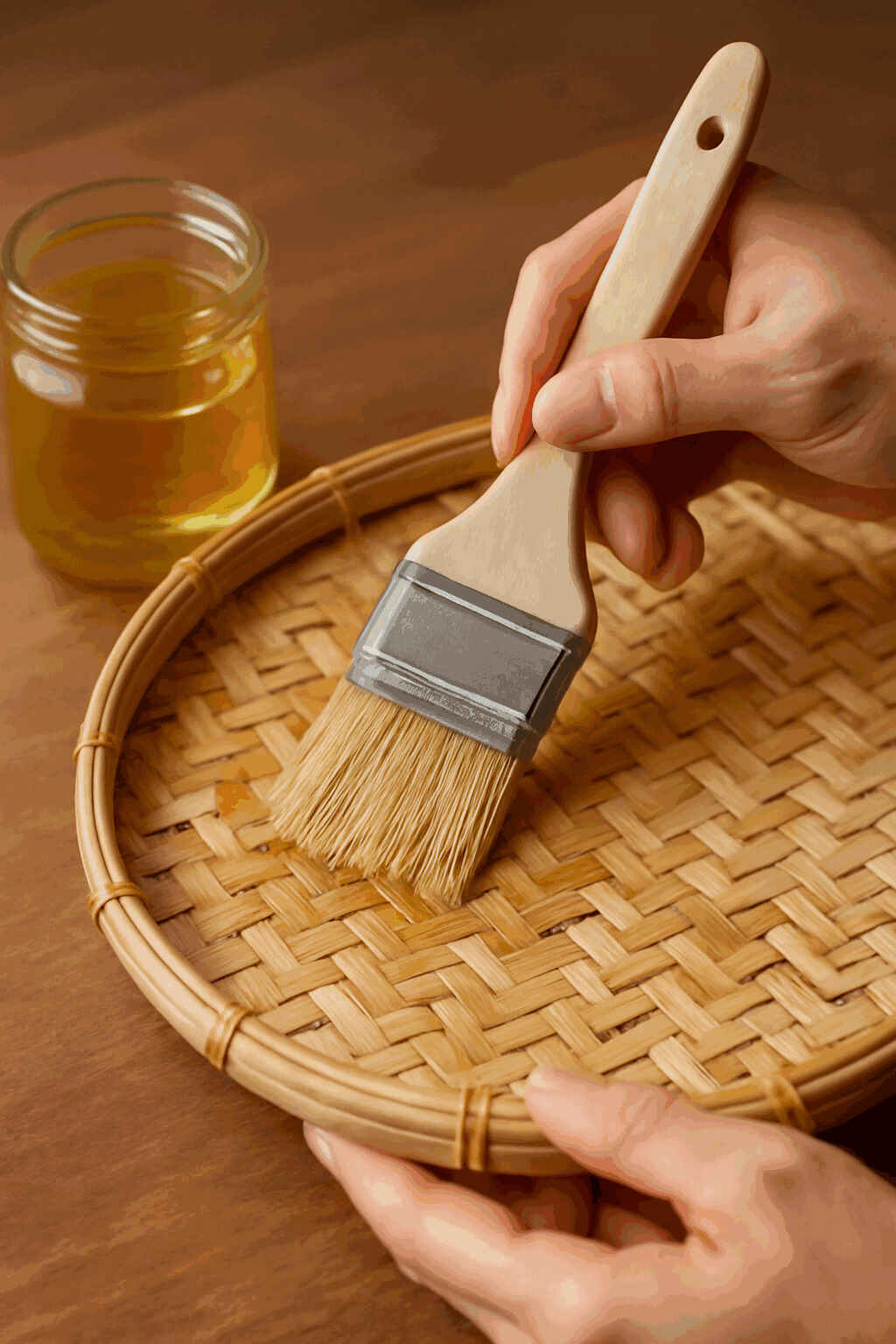
Step 3: Applying a Pre-Stain or Primer (Non-Negotiable for Paint)
- For Clear Coats: Use a wood pre-stain conditioner. This helps the bamboo absorb stains and clear coats more evenly, preventing blotchiness.
- For Paint: Use a high-adhesion, bonding primer. It is necessary for creating a surface that the paint can grip onto. Let the primer dry totally according to the manufacturer’s instructions.
Step 4: Applying the Finish
- Oils: Apply a thin coat with a cloth or brush, let it soak in for 15-30 minutes, then wipe off the excess. Let it dry for 24 hours before applying the next coat. Repeat for 3-4 coats.
- Paints and Varnishes: Use a good-quality brush or sprayer. Apply thin, even coats. Thin coats are always better than the thick coat. Thick coats lead to drips, sags, and longer drying times. Lightly sand between coats with very fine sandpaper (320-grit) to ensure a smooth bond. Wipe away the dust before applying the next coat.
Step 5: Curing
The finish may feel dry to the touch in a few hours, but it takes time to fully “cure” and reach maximum hardness. This can take from several days to several weeks. Avoid heavy use until the cure time has passed.
Part 4: Common Mistakes to Avoid
- Skipping Sanding: This is the number one reason why finishes fail on bamboo.
- Skipping Primer when Painting: The paint will chip and peel.
- Applying Finish in Poor Conditions: Avoid high humidity and extreme temperatures. Ideal conditions are around 70°F (21°C) with low humidity.
- Using Interior Finishes Outdoors: They will break down quickly under UV light and moisture.
- Rushing the Process: Good finishing takes time. Rushing between coats or not allowing for proper curing will compromise the result.
Conclusion: Honoring the Material
Finishing bamboo is a rewarding process that bridges traditional craftsmanship with modern materials. By understanding the unique nature of bamboo and following a meticulous preparation and application process, you can ensure your bamboo products and crafts are not only beautiful but also protected for years to come. Whether you choose a clear oil to celebrate its natural elegance or a vibrant paint to express your creativity, the right bamboo finishing will honor the remarkable qualities of this sustainable grass. So we suggest, take your time, prepare properly, and then transform your bamboo into a lasting work of art.
Reference Website:https://en.wikipedia.org/w/index.php?search=finishing+bamboo&title=Special%3ASearch&ns0=1

